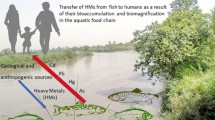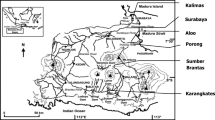Abstract
To understand the effect of metals on the marsh frog Pelophylax ridibundus and the possible environment-induced changes in oxidative stress enzymes, we determined the concentrations of 18 metals: Al, As, Ba, Ca, Cd, Co, Cr, Cu, Fe, Ga, Hg, In, Li, Mn, Ni, Pb, Sr, and Zn, in the tissues (liver, skin, and muscle) and water samples collected from different locations in Serbia. The activities of superoxide dismutase (SOD), catalase (CAT), glutathione peroxidase (GSH-Px), glutathione reductase (GR), glutathione S-transferase (GST), acetylcholinesterase (AChE), and changes in concentrations of reduced glutathione (GSH) and sulfhydryl groups (SH) were analyzed in the tissues of the sampled frogs. The concentrations of Al, Cd, Co, Cr, Cu, Fe, Ga, Hg, and Ni were highest in the liver, whereas those of Ba, Ca, Li, Mn, Pb, Sr, and Zn were highest in the skin. Hg correlated positively with liver SOD (in frogs from Danube-Tisza-Danube Canal (DTD)), muscle CAT (DTD), and muscle GST Ponjavica River (PO); Pb demonstrated a strong positive correlation with liver GR in frogs from Mt. Fruška Gora (FG); Cd only exhibited a positive correlation with AChE in the skin of frogs from DTD. In the skin, Zn correlated positively with AChE (DTD), SH groups (PO), and CAT (FG), and negatively with CAT, GST, and SH in the liver of frogs from DTD. Examination of these oxidative stress biomarkers, together with analysis of metal accumulation in the liver and skin of marsh frogs, provides a powerful tool for the assessment of metal pollution.


Similar content being viewed by others
Abbreviations
- SOD:
-
Superoxide dismutase
- CAT:
-
Catalase
- GSH-Px:
-
Glutathione peroxidase
- GR:
-
Glutathione reductase
- GST:
-
Glutathione S-transferase
- GSH:
-
Glutathione
- SH:
-
Sulfhydryl groups
- AChE:
-
Acetylcholinesterase
- DTD:
-
Danube-Tisza-Danube Canal
- PO:
-
River Ponjavica
- FG:
-
Fruška Gora Mountain
- NADPH:
-
Nicotinamide adenine dinucleotide phosphate
- GSSG:
-
Oxidized glutathione
- CDNB:
-
1-Chloro-2,4-dinitrobenzene
- DTNB:
-
5,5′-Dithiobis-(2-nitrobenzoic acid)
- ICP-OES:
-
Inductively coupled plasma atomic emission spectrometry
References
Aliko V, Hajdaraj G, Caci A, Faggio C (2015) Copper induced lysosomal membrane destabilisation in haemolymph cells of Mediterranean green crab (Carcinus aestuarii, Nardo, 1847) from the Narta Lagoon (Albania). Braz Arch Biol Technol 58:750–756
Bartoskova M, Dobsikova R, Stancova V, Zivna D, Blahova J, Marsalek P, Zelníckova L, Bartos M, Di Tocco FC, Faggio C (2013) Evaluation of ibuprofen toxicity for zebrafish (Danio rerio) targeting on selected biomarkers of oxidative stress. Neuroendocrinol Lett 34:102–108
Birungi Z, Masola B, Zaranyika MF, Naigaga I, Marshall B (2007) Active biomonitoring of trace heavy metals using fish (Oreochromis niloticus) as bioindicator species. The case of Nakivubo wetland along Lake Victoria. Phys Chem Earth 32:1350–1358
Borković-Mitić S, Pavlović S, Perendija B, Despotović S, Gavrić J, Gačić Z, Saičić Z (2013) Influence of some metal concentrations on the activity of antioxidant enzymes and concentrations of vitamin E and SH-groups in the digestive gland and gills of the freshwater bivalve Unio tumidus from the Serbian part of Sava River. Ecol Ind 32:212–221
Casalino E, Sblano C, Landriscina C (1997) Enzyme activity alteration by cadmium administration to rats: the possibility of iron involvement in lipid peroxidation. Arch Biochem Biophys 346:171–179
Castiglione S, Todeschini V, Franchin C, Torrigiani P, Gastaldi D, Cicatelli A, Rinaudo C, Berta G, Biondi S, Lingua G (2009) Clonal differences in survival capacity, copper and zinc accumulation, and correlation with leaf polyamine levels in poplar: a large-scale field trial on heavily polluted soil. Environ Pollut 157:2108–2117
Claiborne A (1984) Catalase activity. In: Greenwald RA (ed) Handbook of methods for oxygen radical research. CRC Press Inc, Boca Raton, pp 283–284
Cossu C, Doyotte A, Babut M, Exinger A, Vasseur P (2000) Antioxidant biomarkers in freshwater bivalves, Unio tumidus, in response to different contamination profiles of aquatic sediments. Ecotoxicol Environ Saf 45:106–121
Eaton DL, Stacey NH, Wong KL, Klaassen CD (1980) Dose–response effects of various metal ions on rat liver, metallothionein, glutathione, heme oxygenase and cytochrome P–450. Toxicol Appl Pharmacol 55:393–402
Ellman GL (1959) Tissue sulfhydryl groups. Arch Biochem Biophys 82:70–77
Ellman GL, Courtney KD, Andres V Jr, Featherstone RM (1961) Determination of acetylcholinesterase activity. Biochem Pharmacol 7:88–95
Falfushinska HI, Romanchuk LD, Stolyar OB (2008) Different responses of biochemical markers in frogs (Rana ridibunda) from urban and rural wetlands to the effect of carbamate fungicide. Comp Biochem Physiol C 148:223–229
Farombi EO, Adelowo OA, Ajimoko YR (2007) Biomarkers of oxidative stress and heavy metal levels as indicators of environmental pollution in African cat fish (Clarias gariepinus) from Nigeria Ogun River. Int J Environ Res Public Health 4:158–165
Fazio F, Marafioti S, Torre A, Sanfilippo M, Panzera M, Faggio C (2013) Haematological and serum protein profiles of Mugil cephalus: effect of two different habitats. Ichthyol Res 60:36–42
Fazio F, Piccione G, Tribulato K, Ferrantelli V, Giangrosso G, Arfuso F, Faggio C (2014) Bioaccumulation of heavy metals in blood and tissue of striped mullet in two Italian lakes. J Aquat Anim Health 26:278–284
Glatzle D, Vuilleumier JP, Weber F, Decker K (1974) Glutathione reductase test with whole blood, a convenient procedure for the assessment of the riboflavin status in humans. Experientia 30:665–667
Griffith OW (1980) Determination of glutathione and glutathione disulfide using glutathione reductase and 2-vinylpyridine. Anal Biochem 106:207–212
Gurer H, Ercal N (2000) Can antioxidants be beneficial in the treatment of lead poisoning? Free Radic Biol Med 29:927–945
Habig WH, Pabst MJ, Jakoby WB (1974) Glutathione S-transferases. The first enzymatic step in mercapturic acid formation. J Biol Chem 249:7130–7139
Hermes-Lima M (2004) Oxygen in biology and biochemistry: role of free radicals. In: Storey KB (ed) Functional metabolism: regulation and adaptation. Wiley, New York, pp 319–368
ICPDR (2006) Water quality in the Danube River Basin. TNMN Yearbook, Vienna
Jaishankar M, Tseten T, Abalagan N, Mathew BB, Beeregowda KN (2014) Toxicity, mechanism and health effects of some heavy metals. Interdiscip Toxicol 7:60–72
Ji X, Hu W, Cheng J, Yuan T, Xu F, Qu L,Wang W (2006) Oxidative stress on domestic ducks (Shaoxing duck) chronically exposed in a mercury–selenium coexisting mining area in China. Ecotoxicol Environ Saf 64:171–177
Labieniec M, Gabryelak T (2007) Antioxidative and oxidative changes in digestive gland cells of freshwater mussels Unio tumidus caused by selected phenolic compounds in the presence of H2O2 or Cu2+ ions. Toxicol in Vitro 21:146–156
Lance V, Cort T, Masuoka J, Lawson R, Saltman P (1995) Unusually high zinc concentrations in snake plasma, with observations on plasma zinc concentrations in lizards, turtles and alligators. J Zool 235:577–585
Lionetto MG, Caricato R, Giordano M, Schettino T (2003) Acetylcholinesterase as biomarker in environmental biomonitoring. In: Parveen M, Kumar S (eds) Recent trends in the acetylcholinesterase system. Ios Press, Amsterdam, pp 91–102
Loumbourdis N, Wray D (1998) Heavy-metal concentration in the frog Rana ridibunda from a small river of Macedonia. Northern Greece. Environ Int 24:427–431
Lowry OH, Rosebrough NJ, Farr AL, Randall RJ (1951) Protein measurement with the Folin phenol reagent. J Biol Chem 193:265–275
Messina CM, Faggio C, Laudicella AV, Sanfilippo M, Trischitta F, Santulli A (2014) Effect of sodium dodecyl sulfate (SDS) on stress response in the Mediterranean mussel (Mytilus galloprovincialis): regulatory volume decrease (RVD) and modulation of biochemical markers related to oxidative stress. Aquat Toxicol 157:94–100
Misra HP, Fridovich I (1972) The role of superoxide anion in the autoxidation of epinephrine and simple assay for superoxide dismutase. J Biol Chem 247:3170–3175
NIVA (Norwegian Institute for Water Research) (2006) Revitalization of the DTD Grand Canal through Vrbas—final report
Orbea A, Ortiz-Zarragoitia M, Solé M, Porte C, Cajaraville M (2002) Antioxidant enzymes and peroxisome proliferation in relation to contaminant body burdens of PAHs and PCBs in bivalve molluscs, crabs and fish from the Urdaibai and Plentzia estuaries (Bay of Biscay). Aquat Toxicol 58:75–98
Pereira P, de Pablo H, Rosa-Santos F, Pacheco M, Vale C (2009) Metal accumulation and oxidative stress in Ulva sp. substantiated by response integration into a general stress index. Aquat Toxicol 91:336–345
Prokić M, Borković-Mitić S, Krizmanić I, Gavrić J, Despotović S, Gavrilović B, Radovanović T, Pavlović S, Saičić Z (2015) Comparative study of oxidative stress parameters and acetylcholinesterase activity in the liver of Pelophylax esculentus complex frogs. Saudi J Biol Sci. doi:10.1016/j.sjbs.2015.09.003
Rana SV (2008) Metals and apoptosis: recent developments. J Trace Elem Med Bio 22:262–284
Regoli F, Gorbi S, Fattorini D, Tedesco S, Notti A, Machella N, Bocchetti R, Benedetti M, Piva F (2006) Use of the land snail Helix aspersa as sentinel organism for monitoring ecotoxicologic effects of urban pollution: an integrated approach. Environ Health Perspect 114:63–69
Rossi MA, Cecchini G, Dianzani MM (1983) Glutathione peroxidase, glutathione reductase and glutathione transferase in two different hepatomas and in normal liver. IRCS Med Sci Biochem 11:805
Sandhir R, Gill KD (1995) Effect of lead on lipid peroxidation in liver of rats. Biol Trace Elem Res 48:91–97
Stolyar OB, Loumbourdis NN, Falfushinska HI, Romanchuk LD (2008) Comparison of metal bioavailability in frogs from urban and rural sites of western Ukraine. Arch Environ Contam Toxicol 54:107–113
Taiwo IE, Amaeze NH, Imbufe AP, Adetoro OO (2014) Heavy metal bioaccumulation and biomarkers of oxidative stress in the wild African tiger frog, Hoplobatrachus occipitalis. Afr J Environ Sci Technol 8:6–15
Takada Y, Noguchit T, Kayiyama M (1982) Superoxide dismutase in various tissues from rabbits bearing the Vx-2 carcinoma in the maxillary sinus. Cancer Res 42:4233–4235
Tamura M, Oshino N, Chance B (1982) Some characteristics of hydrogen- and alkylhydroperoxides metabolizing systems in cardiac tissue. J Biochem 92:1019–1031
Tewari RK, Kumar P, Sharma PN (2008) Morphology and physiology of zinc-stressed mulberry plants. J Plant Nutr Soil Sci 171:286–294
Torre A, Trischitta F, Faggio C (2013) Effect of CdCl2 on regulatory volume decrease (RVD) in Mytilus galloprovincialis digestive cells. Toxicol in Vitro 27:1260–1266
Torres MA, Testa CP, Gaspari C, Masutti MB, Panitz CMN, Curi-Pedrosa R, Almeida EA, Di Mascio P, Wilhelm Filho D (2002) Oxidative stress in the mussel Mytella guyanensis from polluted mangroves on Santa Catarina Island, Brazil. Mar Pollut Bull 44:923–932
Valavanidis A, Vlahogianni T, Dassenakis M, Scoullos M (2006) Molecular biomarkers of oxidative stress in aquatic organisms in relation to toxic environmental pollutants. Ecotoxicol Environ Saf 64:178–189
Vogiatzis A, Loumbourdis NS (1998) Cadmium accumulation in liver and kidneys and hepatic metallothionein and glutathione levels in Rana ridibunda, after exposure to CdCl2. Arch Environ Contam Toxicol 34:64–68
Vogiatzis A, Loumbourdis NS (1999) Exposure of Rana ridibunda to lead. 1-Lead accumulation in different tissues and hepatic δ aminolevulinic acid dehydratase activity. J Appl Toxicol 19:25–29
Wenning RJ, Di Giulio RT, Gallagher EP (1988) Oxidant-mediated biochemical effects of paraquat in the ribbed mussel, Geukensia demissa. Aquat Toxicol 12:157–170
Acknowledgements
This study was supported by the Ministry of Education, Science and Technological Development of the Republic of Serbia, Grant No. 173041. The authors are grateful to Dr. Goran Poznanović for proofreading the manuscript.
Author information
Authors and Affiliations
Corresponding author
Ethics declarations
Animal capture was approved by the Serbian Ministry for Energy, Development and Environmental Protection (Permissions No. 353-01-446/2013-08). All animal procedures complied with the European Directive (2010/63/EU) on the protection of animals used for experimental and other scientific purposes.
Conflict of interest
The authors declare that they have no competing interests.
Additional information
Responsible editor: Thomas Hutchinson
Electronic supplementary material
Below is the link to the electronic supplementary material.
ESM 1
(DOCX 43 kb)
Rights and permissions
About this article
Cite this article
Borković-Mitić, S.S., Prokić, M.D., Krizmanić, I.I. et al. Biomarkers of oxidative stress and metal accumulation in marsh frog (Pelophylax ridibundus). Environ Sci Pollut Res 23, 9649–9659 (2016). https://doi.org/10.1007/s11356-016-6194-3
Received:
Accepted:
Published:
Issue Date:
DOI: https://doi.org/10.1007/s11356-016-6194-3




